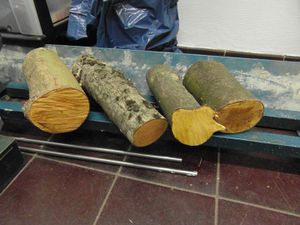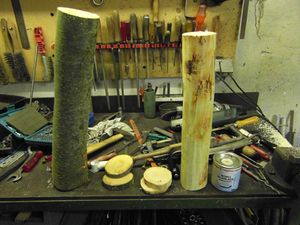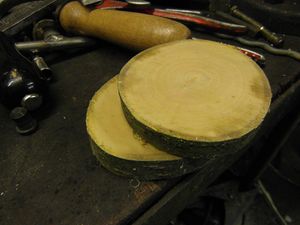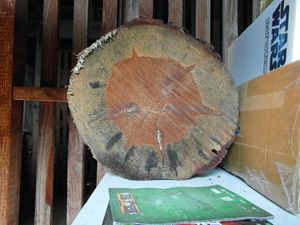Project:Drying Timber: Difference between revisions
From CoMakingSpace Wiki
m →Progress/Results: Robinia dates |
m →Progress/Results: ash date |
||
| Line 112: | Line 112: | ||
! scope="row"| ash | ! scope="row"| ash | ||
| ''large log with "handle" branch'' | | ''large log with "handle" branch'' | ||
| roadside (left over by workers a few days before | | roadside (left over by workers a few days before 2018-3-3) | ||
| cut faces covered when brought to the Space | | cut faces covered when brought to the Space | ||
* [[paraffin]] (melted with [[Heat Gun|heat gun]] right on the wood) | * [[paraffin]] (melted with [[Heat Gun|heat gun]] right on the wood) | ||
| | | | ||
* put under {{£bench}} immediately | * put under {{£bench}} immediately (2018-3-3) | ||
| | | | ||
| ''planned: axe/hammer handles'' | | ''planned: axe/hammer handles'' | ||
Revision as of 22:59, 29 January 2019
| ProjectInfoBox Drying Timber | |
|---|---|

| |
| Status: | ongoing |
| Release Date: | started in 2016, first products in 2018 |
| Initiator: | Lukas |
| Materials Used: | various kinds of wood |
| Tools Used: | pocket chainsaw, hacksaw, drawknife |
Before actively looking for sources of unprocessed timber or rough-cut boards for woodturning blanks or projects like a "river table", I want to experiment with drying and storage techniques to see which works best. Drying too fast will cause the wood to crack while incomplete drying allows fungi to grow.
Here you'll find my experiences! Different woods are tested as they probably won't behave alike.
- some photos
-
apple logs in late 2016
-
apple discs in late 2016
-
the pine log in late 2016
Progress/Results
| Species | Approx. Dimensions | Source | Treatment | Storage | Outcome | Use | Notes |
|---|---|---|---|---|---|---|---|
| pine | log | forest (left over by workers a few weeks before <???>) | bark mostly gone already, no further treatment | uninsulated attic since 2016-9-25 | not too great | (poor) chop block, then firewood (2017-5) | first "attempt" without any effort, no big surprise... |
| apple | log | orchard | cut into pieces for various approaches:
|
|
planned: woodturning | ||
| cherry | small piece | gardener at the JKI Dossenheim (2016-12) | cut faces painted after two months outside
|
|
|||
| maple | small piece | gardener at the JKI Dossenheim (2016-12) | cut faces painted after two months outside
|
|
|||
| beech | small log | sawn from fallen tree (2017-2-5) | cut faces painted after two weeks outside
|
|
planned: mallet head | "marbled" with some kind of fungus (spalting) | |
| Robinia | large log | sawn from fallen tree 2017-10-21 | (top) cut face painted when brought to the Space
|
|
nice overall, some cracks (could have started before treatment) | wedding cake stand (2018-4) | |
| ash | large log with "handle" branch | roadside (left over by workers a few days before 2018-3-3) | cut faces covered when brought to the Space |
|
planned: axe/hammer handles |
Further Ideas
- get/make a moisture meter
- there is an Instructable on kiln drying at home, but it seems to require lots of space and electricity
- try cheaper and ecologically safer options than clear lacquer for painting cut faces
- wood discs can reportedly be placed in a bucket of sawdust to dry, be treated with "wood hardener" or weighed down in a stack and rotated every few weeks
- not tried yet, but as they are really hard to dry it's best to not cut the timber into discs when still fresh!
- write down some of this "theory" part more nicely
- drying speed with grain, role of bark, importance to cover faces
- start with long pieces - gives you room to cut off cracked ends


